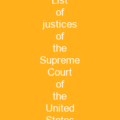The Supreme Court of the United States: A Pillar of American Justice
Imagine the highest court in the land as the ultimate arbiter of justice and law, with the power to shape the very fabric of our nation’s legal system. The Supreme Court of the United States is that institution, a beacon of legal authority and a guardian of constitutional principles.
The Composition and Structure
With nine justices, including one chief justice and eight associate justices, the court operates under a structure designed to ensure impartiality and longevity. These justices serve for life unless they retire, resign, or are impeached, providing stability and continuity in legal interpretations.
The Appointment Process: A Crucial Step
Justices are nominated by the president and confirmed by the Senate. This process is fraught with political implications and public scrutiny, as seen in recent years where confirmation hearings can become intense debates over judicial philosophy and ideology.
A Historical Journey Through Time
The Supreme Court’s history is a tapestry of landmark decisions that have shaped American society. From the early days when only six justices served to the current nine-member bench, each era has brought its own challenges and triumphs.
Key Decisions That Resonate Today
- Roe v. Wade (1973): A pivotal decision that established a woman’s right to choose abortion, sparking decades of debate and legal battles.
- Bush v. Gore (2000): This controversial case halted the Florida recount in the 2000 presidential election, effectively deciding the outcome for George W. Bush.
The Power of Judicial Review: A Controversial Yet Essential Tool
One of the most significant powers held by the Supreme Court is its ability to declare laws unconstitutional through judicial review. This power was first asserted in Marbury v. Madison (1803), setting a precedent that has stood the test of time.
The Impact on Society
Decisions like Griswold v. Connecticut (1965) and Obergefell v. Hodges (2015) have expanded individual rights, while others like Dobbs v. Jackson Women’s Health Organization (2022) have curtailed them, illustrating the profound impact of judicial decisions on society.
The Future: Challenges and Opportunities
The future of the Supreme Court is uncertain as political polarization continues to shape its composition. Critics argue for term limits or mandatory retirements, while supporters defend lifetime tenure as a safeguard against political influence.
Public Perception and Trust
Trust in the court has fluctuated over time, with recent decisions like Dobbs v. Jackson Women’s Health Organization (2022) leading to a significant decline in public trust among Democrats and independents.
The Role of Law Clerks: Shaping Future Decisions
Law clerks play a crucial role in shaping the court’s decisions, often serving as the first drafters of opinions. Their influence can be seen in recent cases where ideological leanings have become more pronounced.
Recent Controversies and Ethics Issues
Controversies surrounding ethics and conflicts of interest have led to calls for reform, including term limits and an enforceable code of conduct. The court’s self-enforced ethics rules are a point of contention in the ongoing debate over judicial accountability.
The Supreme Court: A Symbol of American Democracy
As we look towards the future, the Supreme Court remains a critical institution that balances power and upholds justice. Its decisions continue to shape our nation’s legal landscape, making it an ever-relevant topic in discussions about democracy and human rights.

The Supreme Court of the United States stands as a testament to our nation’s commitment to justice and the rule of law. Its decisions continue to influence society, making it an essential institution in American democracy.
You want to know more about Supreme Court of the United States?
This page is based on the article Supreme Court of the United States published in Wikipedia (retrieved on January 17, 2025) and was automatically summarized using artificial intelligence.







